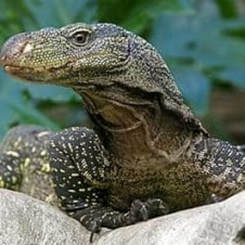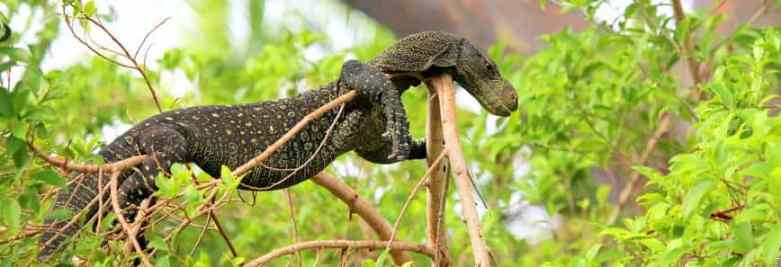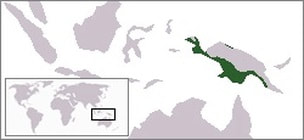Crocodile MonitorVaranus salvadorii |

Custom Search
|
It may even rival or exceed the length of the Komodo dragon, usually regarded as the world's largest lizard because of its sheer bulk and weight up to 200 pounds. There is sexual dimorphism with males being bigger than females because upon reaching sexual maturity females stop growing.
Just like when we try to define which is the biggest snake in the world, there are 2 contenders the green anaconda the heaviest snake and the reticulated python the longest snake. Found n the southeastern part of the island of New Guinea, the crocodile monitor occurs in both the Indonesian region of West Papua and the state Papua New Guinea. The species range remains widely unknown because of its very remote and inaccessible habitat which prevents more detailed studies in its natural habitat. These large lizards inhabit canopies of both lowland rainforests and coastal mangrove swamps from sea level and up to 2000 ft (600 m) high, although on occasion they may venture into other areas during the rainy season because of floods. Crocodile monitors usually spend their days basking on tree branches, but may also be found basking and sleeping on the ground. Sometimes they will stand up on their hind legs to check their surroundings, they are also capable of submerging in water.
These arboreal lizards have a dark green body with yellowish bands with folds in the neck area.
They possess a very characteristic blunt snout and a very long tail which comprises about 2/3 of its total length. The tail is used to help counterbalance its body weight while moving from branch to branch in the tree canopies. The crocodile monitor tail is also a formidable weapon used both for defense and attack. It's used as a whip and is capable of breaking leg bones on dogs and other animals. Unlike other monitor lizards which have blunt teeth, the crocodile monitor teeth are very long and fang-like designed to catch fast-moving prey and hold on to it. Just like the Komodo dragon, its bite is capable of causing an infection leading to death. Like most animals and reptiles, in particular, it will do anything to avoid human contact. Although a crocodile monitor bite can inflict a great deal of damage it rarely proves fatal, even so in 1983, a Papuan woman died from such a bite. Native tribes folklore around the species describes them as an evil spirit that "climbs trees, walks upright, breathes fire, and kills men". They also believe that the crocodile monitor will warn if there are any crocodiles found nearby. Their lifespan is thought to range from 12 to 20 years. 
Subspecies / Etymology / Taxonomy
There are no subspecies recognized by scientists for the crocodile monitor. Their generic name, Varanus, is derived from the Arabic word "waral", which means "lizard". While the specific name, salvadorii, is derived from a Latinization of the name of an Italian ornithologist that worked in New Guinea, Tommaso Salvadori. The species was first described in 1878 as Monitor salvadorii by Wilhelm Peters (German naturalist and explorer) and Giacomo Doria (Italian naturalist, botanist, and herpetologist). But in 1885, George Albert Boulenger renamed the species as Varanus salvadorii. The crocodile monitor scientific name is very similar to that of the Asian water monitor (V. salvator) and they are occasionally confused because of this. Diet / Feeding The crocodile monitor is the top predator in New Guinea but their diet in the wild is poorly known, it will surely prey upon any animal it can overpower. They feed mainly on small mammals like tree kangaroos, cuscus, bandicoots, naked-tailed rats, possums or bats. They also take birds and their eggs, amphibians like frogs, other reptiles like snakes and carrion. Juveniles will feed mostly on insects and small reptiles. There are reports of them taking down prey as big as a pig or deer and even hunting dogs. The crocodile monitor attack with violence with their powerful jaws, after killing the prey they bring it into the tree canopies and eat it. Reproduction The crocodile monitor reproduction has never been observed in the wild, all that is known comes from captivity reproduction. The species reaches sexual maturity at around 2 years of age. To attract females crocodile monitor males will engage in ritualized combats that include, wrestling, head weaving and even bipedal clinching. The winner, usually the larger male, then proceeds to courtship the female by licking, stroking and scratching it. While mating the male might even bite the female in the neck, which results in nasty bleeding wounds known as mating marks. In captivity females will lay up to 3 clutches of 6 to 16 eggs per year, most clutches have proved to be infertile with only a few successful breedings documented so far. Females show a preference for arboreal nest sites. The number of eggs per clutch is linked to female size, larger females produce more eggs. The eggs are laid 3 to 4 months after copulation and hatch around 20 days later. The eggs show sizeable differences in their dimensions and may weigh anywhere from 43 to 61 g, there's no explanation for this phenomenon. Like other monitor species, the juveniles are more colorful than adults specimens and are about 18 inches (46 cm) long and weigh around 56 g (2.0 oz). In the wild, the crocodile monitor like other tree-dwelling monitors species is likely to deposit the eggs in tree hollows or similar sites above ground. Conservation status and main threats The crocodile monitor is listed as Least Concern species in the IUCN Red List and is protected under the CITES Appendix II, requiring a permit to be exported for the international exotic pet trade. Due to their extensive range, the species may be found in protected areas, even though it has no protected status in Indonesian New Guinea. Like many other animal species, it is threatened by deforestation and poaching, they have always been hunted by native peoples for their meat and skin. Sometimes it's hunted and skinned alive and their skin used to make drums. The crocodile monitor is present in an unknown number of private collections and more than 50 specimens are kept in different zoological parks in the US.
|
Scientific classification
Kingdom: Animalia Phylum: Chordata Subphylum: Vertebrata Class: Reptilia Order: Squamata Suborder: Lacertilia Family: Varanidae Genus: Varanus Subgenus: Papusaurus Species: V. salvadorii |


